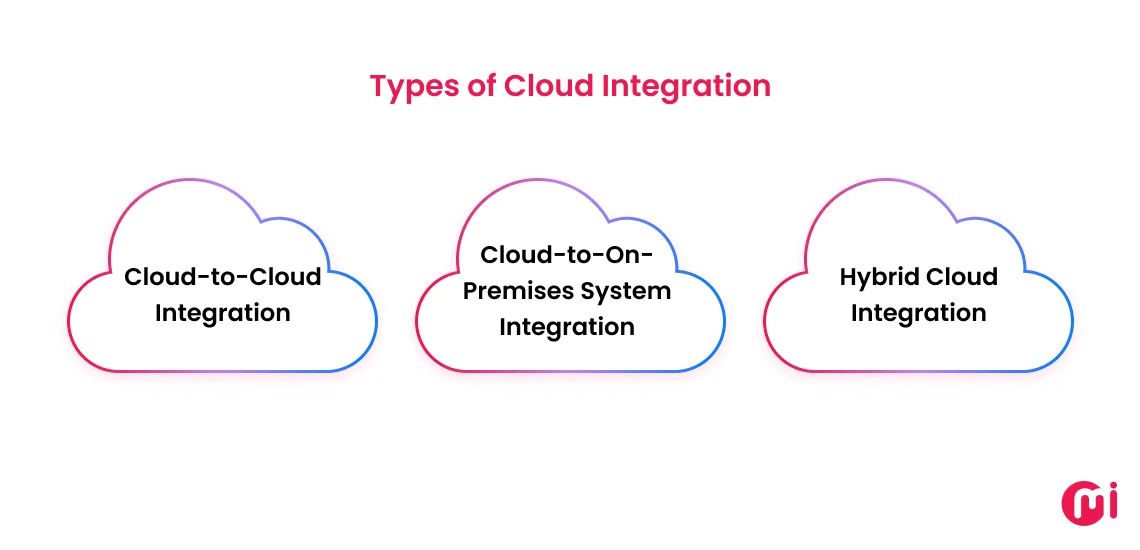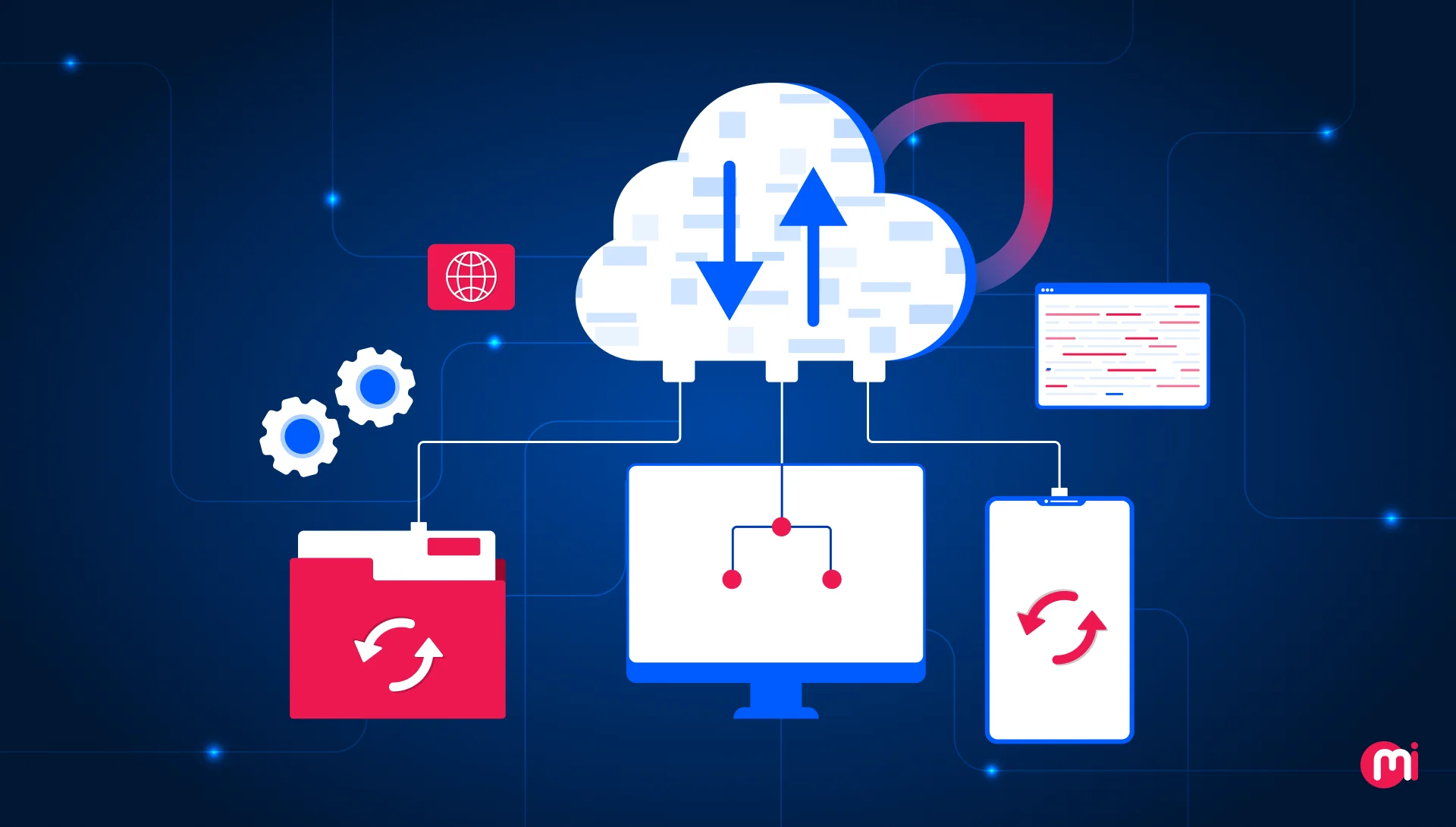What Is Cloud Integration: Benefits, Challenges & Business Impact
- Cloud
- May 26, 2025
With the increasing adoption and reliance on cloud services, understanding how cloud integration works is crucial. This guide is prepared to address all possible queries you may have about cloud integration, covering what it is, its types, benefits, use cases, best practices, challenges, real-world examples, and more. So, let’s identify why aligning your systems in the cloud could be the smartest strategic move you make this year.
We live in an era where every millisecond counts in digital engagement. If your business data is still trapped in siloed systems, it can slow down decisions and the customer service experience. This can also question your business reputation in the market. Fortunately, cloud integration is there, helping you make data accessible and share it at lightning speed.
However, to make your siloed applications talk flawlessly, it requires well-executed cloud integration. So, whether you’re a startup building an application or an enterprise modernizing infrastructure, knowing cloud integration will definitely not disappoint you.
That’s why this blog exists! Through this, you’ll know everything about cloud integration and why it’s imperative for modern businesses today.
| Want to know how you can make the most by integrating your services and platforms with the cloud? Check out our cloud integration services! |
What Is Cloud Integration?
Cloud integration is the process of connecting disparate systems, applications, and data from various sources, including on-premises, cloud, and hybrid environments, to operate as a single, unified framework.
It utilizes technologies like APIs and middleware to enable seamless data exchange, streamline workflows, break down data silos, and improve collaboration, ultimately enhancing operational efficiency, scalability, and business agility.
Want to know more exciting stats about cloud computing? Check out our blog on cloud computing statistics before your competitors do.
Types of Cloud Integration
Cloud integration mainly covers two types of cloud-to-cloud or cloud-on-premises system integrations. By covering both types, it also creates a hybrid cloud integration type, which consists of private and public clouds with on-premises.
Let’s have a detailed look at different types of cloud integration:

Cloud-to-Cloud Integration
In this, two cloud applications and services are integrated, which can either come from the same provider or different ones. For example, integrating a CRM with a Project Management platform. This type of cloud-to-cloud integration is mainly done in businesses using various cloud-based services.
Cloud-to-On-Premises System Integration
In this cloud integration type, cloud applications are integrated with systems/platforms hosted within on-premises infrastructure. This setup is mainly common in businesses looking to embrace an ecosystem covering both cloud-based and on-premises systems. For example, integrating a cloud-based ERP system with an on-premises database.
Hybrid Cloud Integration
It combines both the first two types of cloud integration, cloud-to-cloud and cloud-to-on-premises integration. Here, clouds can be of different types: private cloud + public cloud integrated with systems hosted on-premises.
But can it be called a multi-cloud or hybrid cloud setup? Let’s clear this up with this blog on multi-cloud vs. hybrid cloud.
Using any of the types of cloud integration can help to serve business purposes, including:
Cloud Data Integration: It includes connecting the cloud and on-premises to make centralized data access possible. For example, a business can use cloud integration platforms that help to access customer information from CRM software and team data and who’s working on that customer project from the Project Management module in the same place. It also involves ETL/ELT pipeline creation to ensure consistent data format.
Cloud Application Integration: This type enables businesses to integrate different applications to work in harmony. For example, a process of integrating a food ordering platform with a restaurant vendor platform to automate the flow of food order data between two different systems (customer + vendor system). This allows restaurants to know when a customer orders a food item from their outlet and updates customers when service vendors accept their order and start preparing, and more.
With different types of cloud integration, also know types of cloud computing for better information.

Top 10 Benefits of Cloud Integration
The majority of businesses opt for cloud integration to achieve benefits, including optimized efficiency, better communication & collaboration, better data accessibility, and more. Let’s have a detailed look at the benefits of cloud integration:
- Seamless Data Flow & Elimination of Silos: It helps to connect multiple systems that are being used within the organization to create a single source of truth, leading to better data accessibility. iPaaS tools like Mulesoft or Boomi help a lot to automate data synchronization between apps without coding.
- Cost Efficiency & Reduced IT Overhead: Cloud integration enables you to shift to a pay-as-you-go model, enabling better optimization of cloud resources and reduced IT overhead.
- Scalability for Business Growth: The stateless architecture used in containerized cloud-native app solutions helps to scale horizontally efficiently and even automate by defining scaling matrices.
- Enhanced Collaboration & Remote Work: Cloud integration is extremely beneficial for remote teams. It enables them to access data from anywhere across the globe over internet connectivity and work on the same documents simultaneously, and that too regardless of the device type they are using. All they need is an SSO (Single Sign-On) option to get access to that particular cloud account.
- Improved Security & Compliance: The majority of cloud service providers heavily invest in cloud data security, like up to $1B+/year (like AWS). This makes moving to cloud platforms more reliable not just in terms of security but also compliance.
- Faster Innovation with AI/ML Tools: In the history of digital technologies, cloud technology has emerged as the most flexible technology that can easily integrate with any other tech. When it comes to AI, cloud platforms offer pre-built AI services, like chatbots (Azure Bot Service), predictive analytics (Google Vertex AI), and more. Hence, integration or a strategic move to cloud platforms opens up faster gateways to data & AI innovation.
- Business Continuity & Disaster Recovery: Cloud integration enables businesses to benefit from automated backup, multi-region failover, and disaster recovery, leading to guaranteed 99.99% uptime. Quarterly testing of the DR plan can help businesses continue benefiting from these.
- Competitive Advantage: Companies that integrate their services and platforms with the cloud enjoy the benefits of outpacing competitors by launching features 2x faster and leveraging data to personalize customer experience (CX). In this, serverless computing helps to prototype ideas without infrastructure delays.
- Eco-Friendly Operations: Integrating services and software with the cloud means relying more on cloud data centers, which are known for being 5x more energy-efficient than on-prem infrastructure. The major reasons behind this include cloud data storage spaces using renewable energy and dynamic cooling systems. If this is the goal, then choosing Google’s carbon-neutral cloud benefits more.
- Customer Experience (CX) Boost: When integrated data systems are used with the cloud, they offer unified data sources and even 360° customer profiles. These systems can use that data to offer AI-powered recommendations, elevating customer experiences over your cloud-enabled software.
Elements of Cloud Integration
Platform integration, APIs, middleware, master data management (MDM), EDI, enterprise service bus (ESB), and many others act as a few of the elements of cloud integration. However, there are three key elements of cloud integration, including iPaaS, API, and middleware.
Let’s dive deeper to know the key elements of cloud integration:
- Integration Platform as a Service (iPaaS): It’s a suite of cloud services that simplifies the integration of any combination of on-premises and cloud-based applications with automation. It enables businesses to benefit from faster integration cycles with lower integration costs, along with the enablement of better, on-demand scalability. Plus, iPaaS serves as the most important foundation for cloud services integration.
- API Management: The traditional yet relevant in the cloud era, APIs – application programming interfaces – act as a bridge between two individual software applications and cloud services, enabling them to communicate and share data across. Here, the process of creating, publishing, and monitoring APIs in a secure and scalable cloud environment is known as API management.
- Middleware: As the name suggests, middleware is a tech “glue” that you can use to connect two different applications and databases. Here, in the case of cloud integration, it’s mostly cloud databases. Middleware offers better interoperability between two different applications and computing systems. A middleware cloud integration platform enables you to build a hybrid cloud-based application that’s compatible to connect with legacy systems.
Cloud Integration Use Cases Across Industries
Cloud integration is similar for different industries but brings up numerous use cases for each. However, ultimately it leads to seamless data sharing, better accessibility, boosting efficiency, cost efficiency, opportunities to innovate, and more.
But how do different industries use cloud integration for extra domain-specific advantages? Let’s have a deeper look at cloud integration use cases:
1. Healthcare
In healthcare, every second counts, where even the slightest delay due to siloed data can cause harm to patients’ health. Not just that, a healthcare database is the most sensitive and valuable one, which requires top-notch security.
Leveraging technologies like AI in cloud security can help safeguard patient data more effectively, reducing vulnerabilities and risks. If they fail to secure patient data, it can make healthcare sectors pay millions to billions of dollars as a penalty.
There, integration of cloud computing in healthcare comes as a ray of hope as it breaks down data and departmental silos, keeps all hospital departments on the same page, streamlines operations, and ultimately helps to deliver patient care at speed and with precision. Cloud integration plays a major role in the healthcare legacy system modernization process, leading to considerable advantages.
It offers opportunities to innovate, like integrating AI in healthcare operations (e.g., predictive patient care, remote patient care) and enabling real-time patient engagement.

2. Finance
After healthcare data becoming sensitive information, financial data comes second in that category, requiring utmost patient data security. Amidst the digital transformation of banking and financial operations, there’s also a rising demand for bringing financial information and operations to the fingertips.
With cloud integration, financial institutions can have cloud-based solutions in place that enable real-time monitoring of transactions to assess risks, enable personalized advisory services (integrating AI in fintech operations), and more to reduce the customer churn rate.
3. Sports
In modern sports, cloud integration plays a crucial role in helping teams track and manage athlete performance, manage games, and improve fan engagement (through online live sports telecasts).
Cloud enables the connection of wearable technology and computer vision-powered camera data to gather real-time data on athletes’ vital signs, movement, and other performance metrics. Further, the integration of AI in sports with cloud platforms enables teams to get insights on players’ performance and enforce personalized training, recovery, and potential injury risks.
Cloud integration also becomes a key technology in helping sports broadcasting platforms to improve fan engagement by delivering interactive content and enhanced in-venue engagement. It enables them to personalize live game broadcasting by selecting their fan camera with preferences to see their favorite players only (like F1 TV, NBA, and other popular sports streaming platforms are providing).
4. Education
Every 5 of the Fortune 500 companies are embracing the culture of distance learning within their organization to skill up their employees. In academics, around 49% of students across the world have pursued online learning in some form. (April ABA) Only in the US, 63% of students pursue online learning. This is also deciding the future of online learning, making the market reach $370 billion by 2026. (Statista)
To make online learning possible, the integration of cloud computing in education plays a vital role. Cloud integration is making online learning possible through LMS systems, providing easy and anytime access to digital resources, enhancing real-time collaboration between teachers and students with virtual classrooms, streamlining administrative tasks in universities, and more.
5. Real Estate
Many businesses in the real estate industry are still away from digital transformation and adopting cloud solutions.
With cloud integration, real estate businesses can have centralized data storage offering enhanced data management and access, improved collaboration and communication between construction and real estate firms for better construction project management, advanced analytics and decision-making (by integrating AI in real estate operations), and more.

Cloud Integration Best Practices
Cloud integration involves various steps. However, among many stages, planning, prioritizing security, tools/approach selection, modular approach, and documenting everything stand out as the best tried and tested cloud integration best practices.
Alongside best practices, a cloud migration checklist ensures effective planning by outlining key steps like assessment, tool selection, and security, helping streamline the entire migration process.
Let’s dive deeper to understand each cloud integration best practice:
1. Define Business Objectives & Integration Scope
Start with a plan creation. This includes knowing your business goals for cloud integration, like whether to enhance agility, enable data-driven decisions, or something else. After knowing all, map your integration scope accordingly.
2. Prioritize Data Security
Your goals for easy accessibility to data should not be a victory for hackers to get their hands on your data stored in the cloud. Hence, security must be foundational. Right from the start, you must aim to adopt:
- End-to-end encryption during data transfer
- Role-based access control
- Multi-factor authentication
- Regular security audits
- Frequent backups
- Firewalls and intrusion detection systems (IDS)
- Patch management
- Compliance measures (GDPR, HIPAA, etc.)
- Providing security training to employees
3. Choose the Right Integration Approach
Identify which one from point-to-point, iPaaS, API-led, ETL tools, or middleware-like cloud integration elements suits your ecosystem best, as well as aligns with your scalability and agility needs.
4. Standardise Data Formats
Use standard data formats (like JSON, XML, or EDI) and schemas to ensure consistency and compatibility across all systems. This reduces friction and simplifies data mapping.
You can leverage AI/ML algorithms to auto-discover schema relationships across systems. You can leverage our data science services to train models to auto-map fields, normalize values, and predict data mismatches. You can even employ NLP-driven bots to handle unstructured or semi-structured data (emails, forms, support chats).
5. Take the Modular Integration Approach
Start small rather than going in bulk with cloud integration. The modular cloud integration approach allows you to break integrations into modular, reusable components. This not only reduces redundancy but also makes it easier to maintain and scale individual flows as your business evolves.
6. Design for Scalability
The biggest motivation behind approaching cloud integration is the scalability. To make cloud support that, you should also design your architecture to scale as your business grows. Following this strategy from the start will help your business scale without a major system overhaul.
7. Document Everything
Ensure that you document every process and outcome in your cloud integration process. Documenting integration flows, endpoints, APIs, data formats, and governance rules used in cloud integration helps you ensure continuity, especially across teams or vendors.
8. Ensure Continuous Data Quality & Governance with AI
Leveraging data engineering solutions, plan to implement self-healing data pipelines that auto-detect and correct data issues. You can also use machine learning solutions to detect sport data drift, outliers, or integrity issues in real time.
Moreover, leverage AI development services to maintain robust data lineage, access controls, and compliance alerts. This continuous assurance of data quality and governance with AI leads to higher trust in data, audit-ready processes, and fewer escalations.
Common Cloud Integration Challenges & Solutions
While offering numerous cloud integration benefits, it also presents several challenges during or post integration, such as data security and compliance, integration complexity, data migration issues, vendor lock-in, and more. Overcoming these cloud computing challenges also requires careful planning and a collaborative approach.
So, let’s have a look at five common cloud integration challenges and their possible solutions:
Challenge 1: Data Security Concerns
While the cloud makes data more accessible, it also introduces new security risks. This requires organizations to ensure that their data, whether in transit or at rest, is protected as well as compliant with industry-specific regulations.
Solutions: Implement strong encryption and access control, and do regular security audits. Leverage cloud security services and tools and stay informed with the latest security standards and best practices.
Challenge 2: System Compatibility and Integration Complexity
Some cloud services can be complex when dealing with different API standards and protocols. When enterprises using legacy systems plan to integrate cloud into their infrastructure, they may face challenges.
Solutions: Use middleware solutions, APIs, and cloud-native services to ease integration. If necessary, do modernize legacy systems to avoid tech debt knocking on the door in the near future.
Challenge 3: Data Migration
Moving data to the cloud at scale can be a challenging process, specifically if inconsistent data formats and legacy systems are involved.
Solutions: Audit data, create a data migration strategy, and use data migration tools to execute the process smoothly. You can also use the data preprocessing, like clearing and transformation processes, to ensure data quality and integrity for the migration.
Challenge 4: Cost Management
With the cloud offering better scalability of resources on demand and a pay-as-you-go model, it also gets complex when it comes to cost management.
Solutions: Implementation of cloud cost monitoring tools and creation of cloud cost optimization strategies for resource provisioning can help.
Challenge 5: Interoperability & Vendor Lock-In
Cloud integration typically involves cloud-to-cloud, cloud-to-on-premises, or hybrid setups. However, when these environments span multiple platforms, services, and vendors, each adhering to different protocols and standards, interoperability becomes a challenge. This fragmented ecosystem also increases the risk of vendor lock-in, limiting future flexibility and innovation.
Solutions: Adopt open standards and protocols (RESTful APIs, GraphQL, SOAP, JSON, XML); choose an iPaaS that supports multi-vendor environments; use loosely coupled architecture/systems; leverage containerization; and implement a multi-cloud strategy.
Also check best practices to achieve interoperability in healthcare operations.

Real-World Examples of Cloud Integration
When showcasing real-world case studies about companies leveraging cloud integration to transform their reliance on IT infrastructure, there are many big names, like Netflix, General Electric, Airbnb, Spotify, and more. To name a few, below are the real-world examples of companies that have achieved successful cloud integration:
1. Cleveland Clinic: Cloud-Powered Healthcare Innovation
Industry: Healthcare
About Cleveland Clinic: It’s an American non-profit academic medical center best known for many medical breakthroughs, like coronary artery bypass surgery and the first face transplant in the US. Hence, it’s No. 2 in the world after the Mayo Clinic.
Challenges: As one of the world’s top hospitals, Cleveland Clinic faced critical hurdles:
- Siloed patient data across EHRs, labs, and imaging systems.
- Growing demand for telehealth (especially post-COVID).
- Need for predictive analytics to improve outcomes while maintaining HIPAA/GDPR compliance.
Solutions: Cleveland Clinic partnered with Google Cloud to build a unified healthcare platform, leveraging:
- Google Cloud Healthcare API – To securely integrate EHRs (Epic, Cerner) and IoT devices.
- BigQuery & AI/ML tools – To analyze 100M+ patient records for predictive insights.
- Apigee API Management – To connect third-party apps (e.g., telehealth portals) without compromising security.
- Chronicle Security – To monitor threats in real-time for HIPAA-compliant data protection.
Results:
- Predictive analytics is saving lives.
- Enablement of telehealth services, like an increase in supportability for virtual visits and proactive remote monitoring.
- Improved operational efficiency.
- Google’s “zero trust” model protects 7M+ patient records
- Saved over $600 million dollars in costs.
Also check out how Google Cloud benefits healthcare organizations!
2. Capital One: Full Cloud Migration in Financial Services
Industry: Banking
About Capital One: Capital One is an American bank that’s been in business for over 31 years now and is one of the Fortune 100 companies.
Challenges: To continue to work uniquely with technology as one of the top 10 U.S. banks, Capital One faced mounting pressures with:
- Aging mainframe systems that couldn’t support digital innovation, which needed to go through legacy system modernization services.
- Increasing security threats in the financial sector
- Need for real-time fraud detection to combat sophisticated scams
Solutions: Transitioned entirely to AWS, becoming one of the first US banks to decommission physical data centers (going all in on the cloud).
- Amazon EC2, AWS Lambda, Amazon DynamoDB – To develop capital One intelligent assistant (Eno)
- Amazon EC2, AWS Lambda, and Amazon Simple Notification Service (Amazon SNS) – To develop the Capital One mobile app powered with machine learning and cloud-based and multiregion infrastructure.
- Amazon EC2, Amazon Simple Email Service (Amazon SES), and Amazon RDS – To develop customer experience that helps shoppers save money.
Results:
- Enhanced security with AWS’s compliance frameworks.
- Faster deployment of AI-driven fraud detection tools.
- Cut its disaster recovery time in these testing exercises by 70 percent.
- Reduced critical incident resolution time and the number of transaction errors by 50 percent.
Cloud Integration Trends Shaping the Future
As businesses evolve in the hyperconnected digital world, cloud integration is all about contributing to building an intelligent, agile ecosystem that adapts in real-time. Here are the top cloud trends shaping the future of cloud integration and driving innovation at scale:
Intelligent Automation
Cloud integration is rapidly embracing AI and ML-powered automation to streamline workflows, auto-detect and map data fields between systems, predict and prevent integration failures, and optimize API usage based on demand.
This trend will make cloud environments more self-healing, efficient, and scalable, which is critical in enterprise environments with complex, dynamic data flows. Cloud integration platforms are increasingly integrating with AI services like Vertex AI to enable real-time analytics, intelligent automation, and personalized user experiences at scale.
Integration-as-Code
Integration-as-Code (IaC) is emerging as a developer-centric approach where integration logic is defined and managed using code, just like infrastructure. It enables version control, collaboration, and automated deployment of integrations; supports continuous integration/continuous delivery (CI/CD) for integration pipelines; and enhances security, traceability, and auditability.
Cloud-Native Development
Cloud integration is shifting toward cloud-native architectures. This means integrations are getting done more around containerized, serverless, or microservice-based components. This evolution improves scalability and performance, supports dynamic scaling and event-driven workloads, and ensures portability across cloud platforms.
Looking to embrace this trend? Opt for our cloud application development services!
Your Next Move – Getting Started with MindInventory’s Cloud Integration Services
Cloud integration has now become the backbone for modern business agility, innovation, and resilience. It matters as it helps to break down data silos, enable real-time decision-making, ensure seamless collaboration, slash IT costs while scaling effortlessly, fuel AI-driven innovation, and safeguard against downtime with robust disaster recovery.
So, whether you’re modernizing legacy systems or building a cloud-first startup, the time to act is now. MindInventory, as a leading cloud engineering company, specializes in providing strategic cloud integration solutions that align with your business goals. From API-led workloads to bulletproof security, we’ll help you build an ecosystem that grows as fast as your ambitions.

FAQs About Cloud Integration
Yes, cloud integration can be secure when best practices are followed. If you choose cloud integration platforms that offer built-in security features, such as data encryption, role-based access control, secure APIs, and compliance with standards like GDPR, HIPAA, and ISO/IEC 27001, you can ensure cloud security.
Cloud integration works by using APIs and middleware to connect disparate cloud-based applications and on-premises systems, enabling the seamless exchange of data and automated workflows between them.
Cloud integration utilizes cloud-native platforms, offering benefits like scalability, reduced costs, and accessibility over the internet, while traditional integration relies on on-premises, custom-built middleware that demands significant upfront investment, manual coding, and higher maintenance costs.
Cloud integration reduces costs by eliminating data silos, leveraging scalable cloud services, reducing the need for on-premise hardware, minimizing manual processes, and more.
Healthcare, finance, retail, logistics, manufacturing, and government are the topmost industries benefiting most from cloud integration.
Industry leaders use cloud integration platforms to unify applications, automate business processes, and ensure consistent data flow across departments.
API management, data mapping and transformation tools, real-time and batch processing capabilities, workflow automation, security features, and support for hybrid environments are the essential elements of cloud integration platforms.
Cloud helps modern businesses to connect disparate systems, improve data accessibility, and enable them to innovate faster, respond to market changes, and provide a seamless customer experience across platforms. All these make cloud integration crucial for modern businesses.
Compatible cloud-based applications and services, appropriate integration tools or middleware, and a well-defined integration strategy are the top requirements for cloud integration.
Google Cloud Dataflow, Amazon Web Services (AWS Glue), Microsoft Azure Data Factory, and IBM App Connect are the well-known and top choices as cloud services for data integration.
Popular cloud integration platforms include MuleSoft, Dell Boomi, Workato, Informatica Cloud, SnapLogic, Zapier, and Jitterbit.













